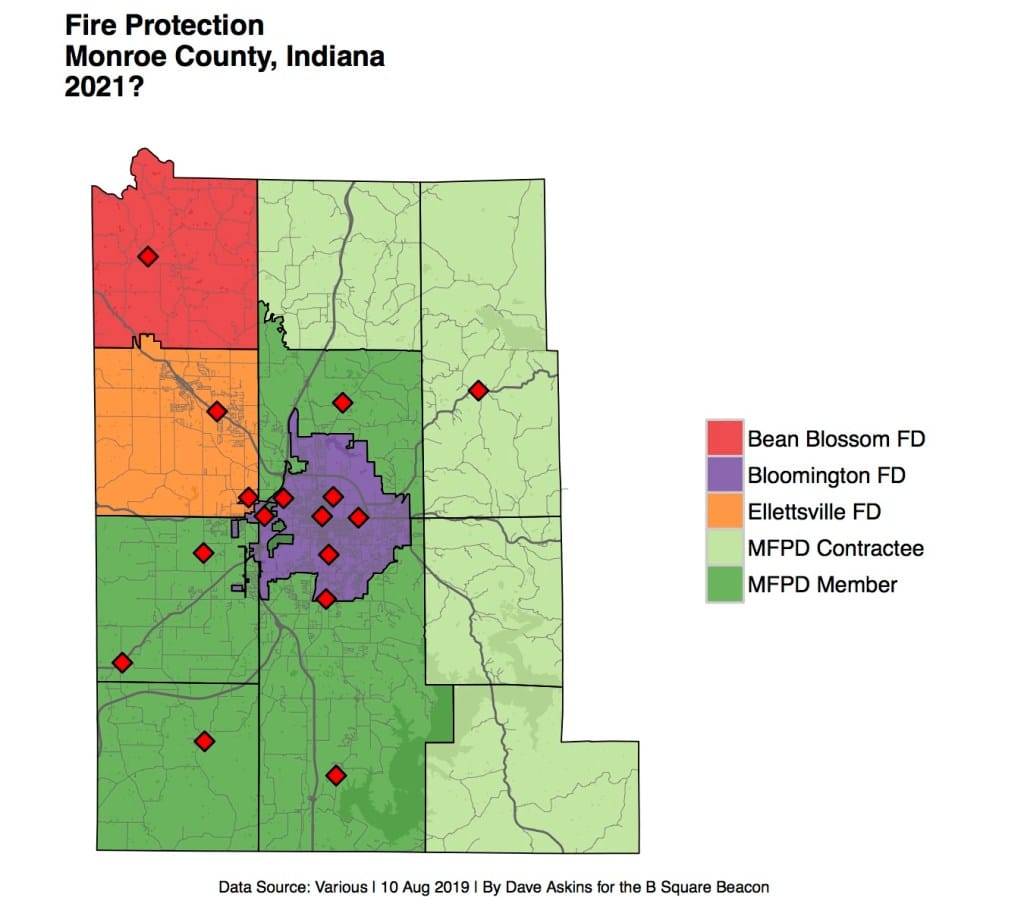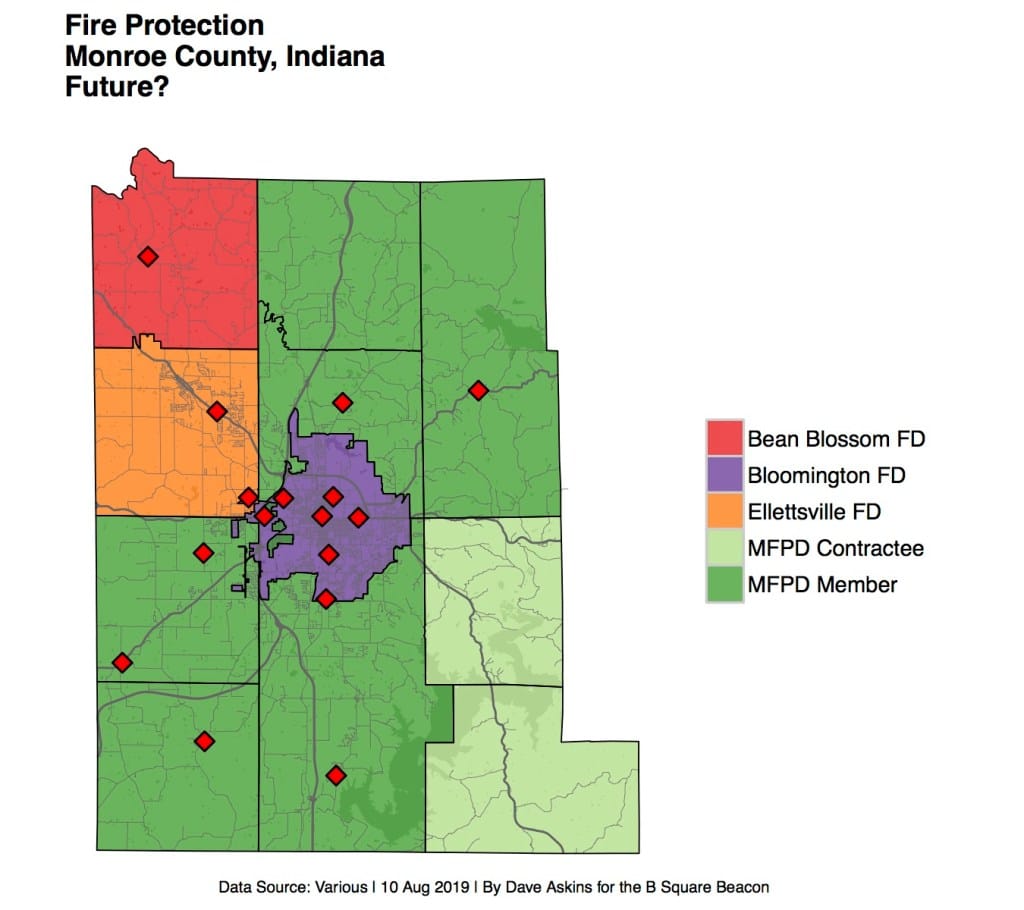Budget 2020: Bloomington fire chief points to improvements in fire call and response time stats, says situation now too fluid to put timeline on new stations



The 10-year capital plan for Bloomington’s fire department includes two additional fire stations—one in the southwest and one in the southeast part of town. It also includes the replacement of two existing stations, and a relocation of the station that serves the Indiana University campus.
Those five stations together have an estimated cost of $28 million, and the three additional fire engines they’ll house will add another $1.8 million.
But those costs aren’t pegged to any particular year in the 10-year plan. So they’re not a part of the proposed $13.25 million budget for 2020, which Bloomington’s fire chief, Jason Moore, presented to the city council on Tuesday night.
Responding to a councilmember question about the timeframe for building new stations, Moore said, “To start making decisions when everything is so fluid, I feel would be rushed and ill-advised. So we will be making recommendations when it’s appropriate and when the entire big picture of public safety can be really painted crystal clear for everyone.”
Moore also told the council that additional improvements in response times would likely depend on adding staff and stations.
Two key considerations that led Moore to call the situation “fluid” are: possible future annexations of land into the city; and the expansions of the Monroe Fire Protection District. The topics are intertwined. At Tuesday’s city council session Moore echoed the sentiments that MFPD chief Justin Dillard expressed a few weeks ago at a public meeting in Bloomington Township, about the restoration of programmed automatic aid among area fire departments.
Moore described the 10-year capital plan in response to questions asked by members of Bloomington’s city council on Tuesday night, after he presented the department’s proposed 2020 budget.
The $13.25 million proposed budget for 2020 would mean about an 11-percent increase over last year’s $11.91 million. The majority of the proposed 2020 budget is personnel—the $10.03 million for personnel reflects a 2-percent increase over last year. Most of the increase is in the area of capital outlays, paid for by the public safety income tax. The 2020 budget calls for $2.11 million compared to $0.94 million in capital expenditures last year.
The biggest part of the 2020 capital budget is $1.15 million for a 75-100 foot aerial ladder truck.
Among the goals Moore highlighted for councilmembers was an improvement in response times—a better than 50 percent drop in average time to respond to a call.
Responding to a councilmember question about false alarms on the Indiana University campus, Moore pointed to reductions in the number of actual fire calls to campus over the last couple of years.
Automatic aid and county departments
At Tuesday’s budget hearing, councilmember Jim Sims asked Bloomington’s fire chief, Jason Moore, about city-county relations. Some of the background of Sim’s question was a kerfuffle between the City of Bloomington and the Monroe Fire Protection District that unfolded in April this year over the way MFPD wanted to portray its relationship with the City to Insurance Service Office (ISO) representatives. The City said in its formal statement, “… the MFPD planned to present the dispatch system components as proof of automatic aid even though the MFPD was aware there were no signed agreements with [Bloomington Fire Department].” As a result Bloomington Fire Department re-programmed the dispatch system components.
If currently planned consolidations of MFPD with other county departments is successful in the coming months, MFPD chief Justin Dillard said at a recent public meeting in Bloomington Township that the number of MFPD firefighters would increase from 14 to 26. At that meeting Dillard told The Beacon that he also expects the expansion of the Monroe Fire Protection District (MFPD) to lead to the re-programming of dispatch software to reflect automatic aid between the City of Bloomington and township areas.
On Tuesday, Moore said the city’s department and departments in the county are still operating under the mutual aid agreement—departments can request each other’s help, it just doesn’t happen automatically through programmed dispatch software.
Moore also told the council the BFD is continuing forward with its plans for combined training of city and county departments. Last week, he said, he’d finalized the agreement on the accountability system, which is used for tracking firefighters on a scene. “We still have good relations, we’re still moving forward,” he said.
If the Monroe Fire District delivers on its promises of extra staffing and its plan for the consolidations with other areas in the county, Moore said, “I don’t see any reason why we can’t get to the point of having a legitimate automatic aid with the county departments in the near future.”



Response Times
Moore told the city council that BFD continues to pursue four- and eight-minute response time goals. The four-minute goal is to respond to 90 percent of calls within four minutes. The eight-minute goal is to respond to 98 percent of calls within eight minutes. The department is currently short of the 4-minute goal, Moore said. BFD responds to 83 percent of calls in four minutes or faster.
Moore said the department has applied performance metric goals and technology but the 83 percent has remained steady. Beyond adding staff and stations, BFD might not ever get closer to the 90 percent goal, Moore said. He said the department might determine that it’s not an appropriate goal.

Moore added that in the last four years, BFD had achieved a 53-percent decrease in average response time. He said he generally didn’t like using averages, because one great call or one really horrible call can destroy an average. Still, he thought it was remarkable that the department had improved from an average response time of 7 minutes and 23 seconds to 3 and a half minutes. Moore said the improvement is partly because of the equipment the department has been able to purchase: “We’re not waiting for a truck to warm-up for four and a half minutes to build up air pressure because it has leaks,” he said.
False Alarms
Councilmember Jim Sims asked Moore about incidents of false alarms on the Indiana University campus. Moore said that Indiana University has the most alarm systems of any organization in the city. The university is adding new buildings and consequently adding more alarms, Moore said, so there are more false alarms overall.
Connected with the department’s prevention efforts, BFD has seen the most progress in the decrease of fires. “False alarms are horrible, they could be a waste of resources,” Moore said. But he added that a false alarm didn’t mean someone would die in a fire. “Seeing a dramatic decrease in fires is something that we’re pretty proud of in that [city-university] partnership,” Moore said.



Retention and Diversity
Sims also asked Moore about the diversity of the firefighter staff and the department’s ability to retain staff.
Moore said the turnover rate per year generally is about 0 to 4 percent. People leave the department mostly due to retirement, he said. One advantage the fire department has over Bloomington’s police department, as far as keeping the department fully staffed, Moore said, is the ability to train its own staff. Moore said the department had just graduated seven people from its 12-week academy.
The department is around 90 or 94 percent white male, Moore said. The rest are women and people of color—about seven people out of 110 staff. The last hiring cycle had seen the most minority applicants ever. The most recent one was made up of 22 percent minorities, compared with 1.2 percent in the previous cycle. BFD does diversity training, Moore said, and that also means training for diversity inclusion. “Preparing our environment for becoming more diverse is just as important as recruiting diversity,” Moore said.
2020 Capital Budget for Bloomington Fire Department
| Item | Amount |
| 75-100 Ft Aerial Ladder (T2) | $1,150,000 |
| Engine/Pumper (E1) | $560,000 |
| Extrication Tools | $120,000 |
| Station 1 Repairs (urgent) | $100,000 |
| Station 2 Repairs (urgent) | $100,000 |
| Fire Fighting Gear | $90,000 |
| Full Sized SUV (P1) | $55,000 |
| Sedan (Pool) | $35,000 |
Undated Elements of Bloomington Fire Department’s 10-Year Capital Plan
| Item | Amount |
| Total – Fire | $34,515,000 |
| New Fire Station (7, Southwest) | $6,000,000 |
| New Fire Station (6, Southeast) | $5,500,000 |
| Relocate Station 3-IU* | $5,500,000 |
| Station 4 Replacement | $5,500,000 |
| Station 5 Replacement | $5,500,000 |
| Training Tower | $1,000,000 |
| Station 2 Repairs (projected) | $815,000 |
| Station 4 Repairs (urgent) | $640,000 |
| Add New Engine 2 (After Station 2 Remodel) | $600,000 |
| Add New Engine 6 (With Station 6) | $600,000 |
| Add New Engine 7 (With Station 7) | $600,000 |
| Station 1 Repairs (projected) | $600,000 |
| Storage/Training Facility | $600,000 |
| Station 2 Addition | $500,000 |
| Station 1 Repairs (urgent) | $450,000 |
| Station 2 Repairs (urgent) | $400,000 |
| Station 5 Repairs (urgent) | $400,000 |
| Station 3 Repairs (urgent) | $310,000 |




Comments ()